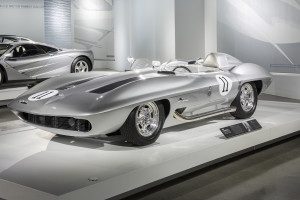Darren DiMaria, Chief Client Officer DCI Solution, had an opportunity to attend a special invitation event at the Petersen Automotive Museum over the weekend. “A must see experience”, stated Darren, “one of the most amazing collections I have ever seen especially the Vault!”
ABOUT THE MUSEUM
One unique feature that separates the Petersen Automotive Museum from other automotive museums is the constantly rotating exhibit spaces. To keep The Museum fresh, relevant, and to keep visitors coming back, it was decided from the beginning not to display the entire Museum Collection at once. In the 100,000+ square feet that comprise The Petersen Automotive Museum, only about 150 vehicles are on display at any one time. The other half of the 300+ vehicle collection is in on-site storage, awaiting the chance to go on exhibition. Depending on the chosen subject, the rotating exhibits can range from 100% Petersen vehicles to 90% on loan.
A large part of The Museum’s focus is to collect and preserve historic vehicles, and a great deal of importance was placed from day one on acquiring a great number of significant vehicles of all shapes, sizes, makes, models, and purposes. As the Museum’s popularity grew as a 501 (c)(3) nonprofit educational institution, people came to realize that it was the perfect tax deductible home for their prized possession. Our first donation was a beautifully restored 1952 Mercedes-Benz 300 Cabriolet from Annapolis, Maryland. Since then, we have taken in donations from all over the world varying greatly from single vehicles, to multiple vehicle collections, rare automobile components, artwork, photographs, books, and automobilia.
MUSEUM HISTORY
If there is one thing that we all have in common, especially in Southern California, it’s the automobile. To some the automobile is an appliance, but to us it is a passion. The Petersen Automotive Museum has been celebrating this passion since 1994 on the corner of Fairfax Avenue and Wilshire Boulevard, the third most travelled intersection in the city of Los Angeles. It anchors one end of the famed “Miracle Mile” created by real estate developer A.W. Ross in 1936. Created in a time before shopping malls, the Miracle Mile centralized shopping in the area and was “The” place to go for high end shopping. Wilshire was also home to various “firsts” including dedicated left-turn lanes and the first timed traffic lights in the United States. Ross also required merchants to provide automobile parking lots behind their stores, all to aid traffic flow.
The Museum’s unforgettable architecture by world renowned architect, Welton Becket was cutting edge when the building was opened in 1962 as Seibu, a Japanese department store. When Seibu left the United States in 1965, Ohrbach’s moved into the building and it became a popular local shopping spot until its closing in 1986. The building stood vacant for approximately 6 years until inspiration struck the late Robert E. Petersen, who was looking for a consolidated headquarters for Petersen Publishing. Upon further investigation, he decided that the near-windowless structure would not be the best choice for an office building, but it would make an excellent museum. To preserve the Museum’s artifacts inside, they need to keep away from the sun’s damaging ultraviolet rays.
Seeing the building’s true potential as an automotive-inspired educational institution, Mr. and Mrs. Petersen put forth a large portion of the money necessary to create the Petersen Automotive Museum. The Museum was to be much more than a large room filled with cars parked in rows like an indoor parking lot. From the beginning, the vehicles chosen for exhibition had to be displayed in context to give them real meaning and a better experience for all who would come to visit. The “Streetscape” was full of architectural elements that were period correct for the vehicles that surrounded them, immersing visitors deep into the stories that were told. The second floor featured rotating exhibit areas and the third floor featured the Discovery Center which taught art and science through the automobile to children of all ages.
The Museum was developed in a mere three years and opened on June 11th, 1994.
To find out more, go to www.petersen.org and enjoy!

